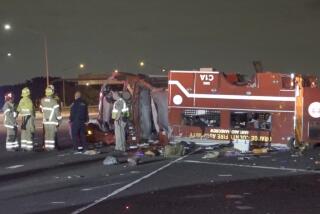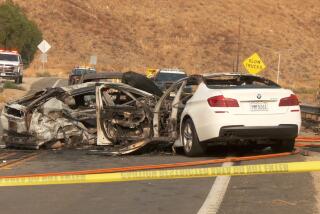Fierce Winds Hamper Untangling of I-5 Pileup : Traffic: Death toll reaches 17. Observers compare carnage to remains of Iraqi vehicles during Gulf War.
- Share via
COALINGA, Calif. — As the death toll in the chain-reaction crash on Interstate 5 reached 17, authorities battled biting winds and blinding sand clouds Saturday to clear one of the state’s worst traffic accidents but could not reopen the main artery linking Northern and Southern California.
Dozens of wrecked cars and trucks--some bunched in orderly rows after crashing, others melted and unrecognizable after a terrible fire--littered the four-lane freeway a full day after a harrowing series of collisions involving 104 vehicles began under a cloak of dust on the day after Thanksgiving. Caltrans officials said they hope the road can be reopened to Thanksgiving weekend traffic by early this morning, after workers finish removing vehicle hulks and temporarily patch the many cracks, scrapes and gouges left in the pavement.
Several people working at the scene compared the mile-long column of wrecked vehicles and smoldering metal to the remains of Iraqi armored vehicles destroyed by American warplanes as they tried to drive out of Kuwait earlier this year.
“I’ve never seen a car accident in California that comes close to being this bad,” said Lt. Gov. Leo T. McCarthy, who toured the crash scene Saturday morning with state Transportation Secretary Carl Covitz. “I’ve never seen such a mess of twisted trucks and cars.”
Road-clearing crews received a scare as darkness fell Saturday when they discovered scores of industrial-sized, potentially explosive oxygen tanks mixed in a shipment of baby-food jars in a charred tractor-trailer. Work stopped until they determined the tanks were empty.
In several Fresno County hospitals, meanwhile, crash victims battled for their lives; three lost the fight Saturday, joining 14 fatalities on the day of the accident.
McCarthy and Covitz agreed with California Highway Patrol officials who blamed the accident on drivers being ambushed by a “freak” dust storm of unprecedented density.
“It was a tragic situation and could not be avoided,” Covitz said.
CHP officials, who spent most of Saturday marking wrecks and diagramming where they came to rest, said it may be six months before an accident investigation team can piece together a chronology of what happened.
“We can look for a cause,” said Deputy Chief John Anderson, commander of the CHP’s central division, which patrols from Modesto to Bakersfield, “but it’s pretty apparent here it was unsafe speed for the conditions, although innocently done.”
People were traveling too fast for a dust storm, he explained, but even if they were aware of the danger the storm came up so fast they didn’t have time to react and adjust to it.
That jibes with the tales being swapped by survivors Saturday over sweet rolls and coffee in the diner of a nearby motel.
Anita Viotto, 61, said she was driving from Sacramento to her home in San Luis Obispo with her son-in-law, when “all of a sudden . . . you couldn’t see anything.”
Her son-in-law, Chuck Baker, 62, said that by the time he saw the red taillights of the big rig in front of him he barely had enough time to veer his minivan onto the shoulder and avoid being compressed accordion-style by the stream of cars behind.
“It was like seeing a wall of sand. I couldn’t even see the front of my car,” said Jaime Peckham, 41, who was in the process of moving from Baltimore to San Francisco when fate--and a Toyota pickup--struck.
Peckham said she was in the slow lane and braked as soon as the dust cloud enveloped the road, stopping a foot short of the car in front of her. She remembered feeling relieved, “and then I looked in the rear-view mirror and I saw the headlights coming. And I said, ‘Oh, God! Please don’t hit me!’ And then, pow!”
Across the table, the man who ran into her, DeBee Corley, 51, of San Jose, said he was trying to decelerate gradually to avoid causing a chain-reaction, but misjudged slightly and hit Peckham’s station wagon at 15 m.p.h. He said he was not rear-ended, but the car behind him was.
Firefighters dispatched to the scene said rescue efforts were badly hampered by the storm, which they said was beyond description.
Doug Hicks, a battalion chief with the California Department of Forestry’s Mid-Valley Fire District, said he had to navigate to the crash site by opening his door, sticking his head out and following the yellow stripe on the pavement.
“That was the only way I could see anything,” Hicks said.
A fire truck, meanwhile, was itself rear-ended on its way to the crash and firefighters could not pry open its back doors to get to a set of “jaws of life,” which were needed to free people trapped in wrecked cars. An ambulance inching its way to injured drivers collided with another vehicle on the way. It did not cause any injuries.
Once on the scene, officials said, it took them considerable time to penetrate the fog of confusion, as well as the dense dust, and discover that the collision involved more than 100 vehicles littered over nearly a mile on both sides of the road.
The first rescuers arrived within a half-hour of the 2:30 p.m. crash, even though it was 20 miles north of Coalinga, the closest town of any size.
In the interim, the CHP’s Anderson said, some of the injured were attended by a doctor and two Northern California firefighters who happened to be driving down the freeway at the time. Anderson said he did not know who the doctor or firefighters were.
When help arrived in strength, some firefighters immediately set out to extinguish a fire that was burning through the largest single clump of vehicles, about 19 cars and two big rigs, in the southbound lanes. That fire burned so hot that it reduced cars to unrecognizable lumps and left rivulets of coagulated aluminum pooled in the dirt median.
Other firefighters and Highway Patrol officers went to other clumps of smashed vehicles, helping some survivors pull others out through the windows of their mangled cars.
Away from the fire, especially on the northbound lanes about a mile away, the white noise of rushing wind blocked out all other sounds and the gray-brown cloak of blowing sand obliterated most sights.
“It was eerie,” Peckham said. “It was like being in a science-fiction movie.”
The blowing sand scratched the eyes and buffed any exposed skin of rescue workers.
“It was like being sandblasted,” said David Eppler, owner of Eppler Towing of Firebaugh, which had all 10 of its trucks working the scene until 1 a.m. Saturday. They returned at 9 a.m. and worked until dark.
More to Read
Sign up for Essential California
The most important California stories and recommendations in your inbox every morning.
You may occasionally receive promotional content from the Los Angeles Times.










